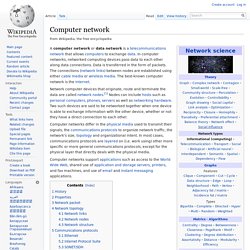

Network Life-cycle Analysis ☆ Team curated. Greenteam for connectivity ☆ Team curated. Cable or Wire Based Networks ☆Team curated. Wireless Networks ☆Team curated. Wireless Electronics (suppliers) ☆Team curated. Satellite Internet ☆Team curated. Computer network. Computer networks differ in the physical media used to transmit their signals, the communications protocols to organize network traffic, the network's size, topology and organizational intent.

In most cases, communications protocols are layered on (i.e. work using) other more specific or more general communications protocols, except for the physical layer that directly deals with the physical media. Computer networks support applications such as access to the World Wide Web, shared use of application and storage servers, printers, and fax machines, and use of email and instant messaging applications. History[edit] A computer network, or simply a network, is a collection of computers and other hardware components interconnected by communication channels that allow sharing of resources and information. Today, computer networks are the core of modern communication. The following is a chronology of significant computer network developments: Properties[edit] Network packet[edit]
Defense Data Network. The Defense Data Network (DDN) was a computer networking effort of the United States Department of Defense from 1983 through 1995.[1] History[edit] In 1975, the Defense Communication Agency (DCA) took over operation of the ARPANET as it became an operational tool instead of a research project. In 1983, plans for a new generation of the Automatic Digital Network (Autodin II) were canceled. Instead, a separate network to connect military installations called MILNET was split off the ARPANET. The ARPANET would be used as an Internet backbone for researchers, but be slowly phased out. As a large-scale, private internet, the DDN provided Internet Protocol connectivity across the United States and to US military bases abroad.
The four DDN subnetworks were: DDN-NIC[edit] Public data network. A public data network is a network established and operated by a telecommunications administration, or a recognized private operating agency, for the specific purpose of providing data transmission services for the public. In communications, a PDN is a circuit- or packet-switched network that is available to the public and that can transmit data in digital form. A PDN provider is a company that provides access to a PDN and that provides any of X.25, frame relay, or cell relay (ATM) services.
Access to a PDN generally includes a guaranteed bandwidth, known as the committed information rate (CIR). Costs for the access depend on the guaranteed rate. PDN providers differ in how they charge for temporary increases in required bandwidth (known as surges). Electronics News ☆Team curated. ☆ Team Information & Help.